|
On 11 May 1943, the 8th Fighter Group became the 8th Assault Group. Three days later,
its pilots and mechanics were sent to Kirovograd, where they started to train on the
Hs-129B2 with German instructors. By August 1943 they had overcome the difficulties of
flying twin-engine aircraft and were ready for action.
On 10 August the 8th Assault Group moved to the front, on the Kramatorskaya airfield,
after a short stay at Mariupol. It conssited of three squadrons: 41st, 42nd and 60th. Lt.
cdor. av. Dutu Vasiliu, the new commanding officer, joined the group, replacing cpt.
av. Ioan Cara. The first mission was flown on 15 August by 12 Hs-129Bs, with good results.
As a consequence, Il-2s attacked the airfield later that day, destroying one aircraft.
On 17 August, the Group executed 46 sorties against Soviet troop concentrations. The
German intelligence intercepted a Soviet transmission saying that it is impossible to
advance because of the attacks of Romanian assault aircraft. The airfield was attacked
again. The first loss ocurred on 19, when adj. av. Petre Sârbu was gravely wounded. He
managed to get back to the airfield, but he crashed and died.
The missions went on the following days. Adj. av. Dumitru Marinescu earned an Iron Cross
2nd class on 23 August for destroying a Soviet mobile AA gun during his fourth mission that
day, when 8 Hs-129Bs struck Soviet infantry with grenades. He was severely hit and barely
managed to get back to Kramatorskaya, where he crash-landed his airplane.
The group performed a special recon mission on 30 August in an area on the river Mius.
The Luftwaffe had already lost Fw-189s to the objective's powerful AA defence. Four
aircraft led by adj. av. Dumitru Marinescu took off before dawn. They flew really low over
the Azov Sea and passed Taganrog undetected and then they went left on the Donetsk Valley
at the same altitude. As the sun rose, they headed west and passed over the target area at
60-70 m, filming. The surprise was total, as the Soviet AA gunners did not expect to have
Axis aircraft coming from the east. After they landed back at the airfield, the 8th Assault
Group amassed its forces in order to strike fuel and munitions depots uncovered there.
The 41st Squadron was supposed to go on the route used for the recon flight, the 42nd was
supposed to fly at high altitude and attack in a dive, while the 60th Squadron was going to
attack from the west and draw most of the Soviet fire towards it. The objective was
destroyed, without considerable losses.
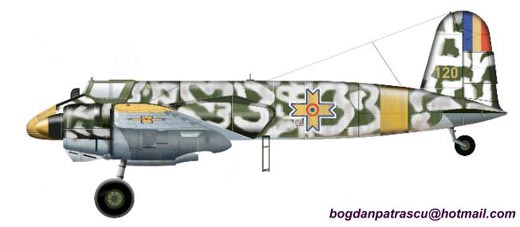
Profile courtesy of
Bogdan Patrascu
A Hs-129B2 in winter camouflage, belonging to the 41st Squadron.
Because of the situation on the front, the group had to move in September to the Staryi
Bliznetzy airfield, but the stream of close air support missions continued, as the Axis
forces in the sector were under a lot of pressure. When returning from one such mission, on
10 September, a very odd incident ocurred. The 16 Hs-129s were flying very low, as usual, at
10-15 m. From a cornfield, a camouflaged T-34 fired one shot, which cut off a part of the
wing of the aircraft of Oblt. Dieter Orth, the German liason officer. The plane hit the
ground and exploded instantly. The rest of the aircraft quickly gained altitude and
discovered 8 hidden T-34s, which had infiltrated behind Axis lines. They returned to the
airfield, reloaded and went back to the cornfield. Within 10 minutes all had been
destroyed.
The next day, adj. av. Teodor Zăbavă, one of the aces of the former 8th Fighter Group
(11 kills)
was brought down by Soviet AAA, but he managed to return to his unit after one day. On 19
September, adj. av. Ion Enache was damaged by AA guns and forced to crash land his aircraft,
the third one in two weeks on the front! Amazingly he survived this time also and the Hs-129
was repairable.
The situation on the front meant that the 8th Assault Group had to move again: first to
Melitopol and then to Kherson. The day of 6 October was an "usual" day for the Romanian
unit. The missions went on one after another. However, for adj. av. Gheorghe Zamfir, it
proved to be a quite an experience. During an attack on Soviet armor near the village of
Shirokoe his aircraft was hit by 20 mm gun fire, just as he had launched his bombs. A shell
had stopped in the armor in his back. He managed to bring it back to the airfield. After 10
minutes he took off in another mission and in another airplane. This time they attacked
artillery positions at Alexandrovka. A well-camouflaged tank fired a lucky shot, which
hit him in the fuselage and cut off a part of his controls. He barely managed to return to
base, where the aircraft broke in two as he was taxiing on the runaway. After 30 minutes
he was back in the air again. The Hs-129B2 formation attacked a Soviet troop concentration
at Guterka. As he fired his guns, an incediary shell hit his ammo, which started to explode.
With the aircraft in flames he headed towards the front line. He managed to put it down and
got out just in time. The Hs-129 exploded. Adj. av. Gheorghe Claru landed next to the
burning wreck, took his wounded comrade on board and returned him safely to the airfield.
On 26 October 1943, 20 Hs-129s stopped in its tracks a Soviet assault on Nikolaev. First
they took out several Soviet batteries, which were trying to neutralize the few German guns
in the sector. On the return trip they surprised Soviet infantry in a village close to the
front and fired all the remaining ammo at it, leaving few survivors on the narrow streets.
The German command in the sector thanked them later for their support.
On 29 October the 8th Assault Group moved to the Chaplinka airfield. During the first
days of November, the Romanian Henschel pilots practically saved the 24th Infantry Division,
which was retreating followed closely by Soviet forces. They managed to fly about 15-16
missions per day each! No other Romanian group made as many sorties in one day, as the 8th
Assault Group did then. There was always a patrulă (Romanian for Schwarm) in the air
covering the infantrymen. Thus they managed to rescue the lives of more than 10,000 men.
Five assault aircraft were lost, as were two pilots. The other three were rescued by their
comrades.
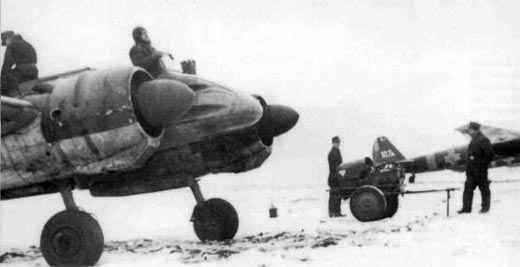
Picture from "Rumanian Air Force, the prime decade 1938-1947" by
Dénes Bernád, Squadron/Signal Publications, 1999
Kherson, November 1943. This Hs-129B2 belonged to the 41st Squadron.
On 13 November the group had to be relocated to the Nikolaev airfield. Despite the
difficult weather conditions, the troops on the front needed their help and they had to
intervene. On 5 December 1943, 16 Hs-129Bs surprised 12-15 T-34s hidden in a small valley
and quickly took them out. Then they went on and discovered Soviet infantry infiltrating
behind Axis lines and attacked it, causing lots of casualties. The 8th Assault Group lost
two aircraft on 15 December, but only one pilot made it back to the airfield: adj. av.
Constantin "Gill" Georgescu. The other one was taken prisoner. Two days later another Hs-129
was shot down. Adj. av. Ion Logofatu did not survive the crash.
On 7 January 1944 they moved to Lepetika. A couple of accidents caused the group to loose
some of its best pilots. First cpt. av. Alfred Conrad was killed during a training flight.
On 27 January, slt. av. Ion Buda was returning from Romania with a repaired Hs-129. He had
taken adj. av. Teodor Zăbavă (the ace of the 8th Assault Group) as a passenger in the
fuselage. Because of the fog, the airplane crashed, killing both pilots.
At the beginning of February, the 42nd and 60th Squadrons moved back to Nikolaev. The
41st remained at Lepetika. A new CO, cdor. av. Luchian, took over the group. On 1
February adj. av. Victor Dumbravă was hit by Soviet AAA during a mission. The left engine
was knocked out and he had to make a belly landing. Adj. av. Vasile Pascu landed close to
him. Dumbravă ran towards the other Henschel, over a frozen lake. The ice broke and he fell
in. Soaking wet, he finally reached Pascu and climbed on the airplane. Pascu managed to
take off from the snow with difficulty and safely took him to Lepetika, where the frozen
Dumbravă received immediate medical treatment. Adj. Pascu was cited on the entire Air Corps.
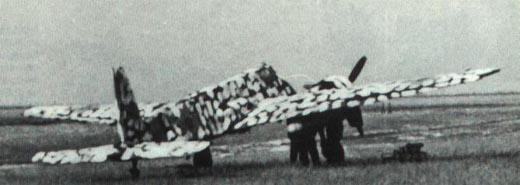
Picture from "Rumanian Air Force, the prime decade 1938-1947" by
Dénes Bernád, Squadron/Signal Publications, 1999
This Hs-129B2 belonged to the 42nd Squadron in the winter of 1943/44.
Note the winter camouflage.
On 2 April 1944, the 8th Assault Group was redeployed to Romania, at Tecuci. A new
commander took over: cpt. cdor. av. Gheorghe Botez. As the Soviets had entered Romanian
soil, the missions came one after another, until around 20 April, when things settled down.
11 pilots left the group temporarily in order to bring new aircraft from Poland. These
arrived just in time for to take part in the battle of Targu-Frumos.
On 1 May the group carried out 40 sorties, mostly without fighter cover. It took two
missions (one with 5 a/c and the other with 11) to deal severe damage to the Soviet troops
near the village Bals. Large explosions were seen. Ten Henschels then struck targets west
of Băiceni and another nine attacked east of Băiceni. The last mission was against the
village of Hărmănesti, just as a Ju-88 formation was approaching the area. About 40 sorties
were flown that day.
But the next day, the Soviets started their attack on a line between Liteni (10 km N
of Targu-Frumos) and the river Moldova. But the line was kept, generally speaking. The
most serious situation was between Giurgesti and the river Siret, where about 30-40 Soviet
tanks penetrated as far as Helesteni. The 8th Assault Group struck Soviet forces advancing
on Dealul Ciobanului (Shephearder's Hill) and the Soviet armored formation north of
Helesteni, destroying three tanks. A third formation attacked the Principele Nicolae
village. However, the Soviets managed to advance 1.5 km south of Bals. One Hs-129 was hit
by AAA, but the pilot managed to make a belly-landing in friendly lines.
The Soviet offensive continued on 3 May. The 8th Assault Group attacked in the
Ruginoasa area, bombing the tanks that had reached the Dâmbrovicioara Hill and strafing
the support infantry. A second mission was flown against Soviet light artillery on the
same hill (approx 1 km S of Ruginoasa). A third formation returned in the area later and
attacked tanks, but VVS P-39s forced half of them to break formation.
On 4 May, the 8th Assault Group flew two missions, totalling 33 sorties. The first one
was against a Soviet column N of Helesteni. Two tanks were destroyed. The second formation
struck Soviet infantry 3km S of Ruginoasa and destroyed a section AT guns. They were
shortly engaged by VVS fighters in the area and even Il-2s. But the Romanian and German
fighters intervened and they got away.
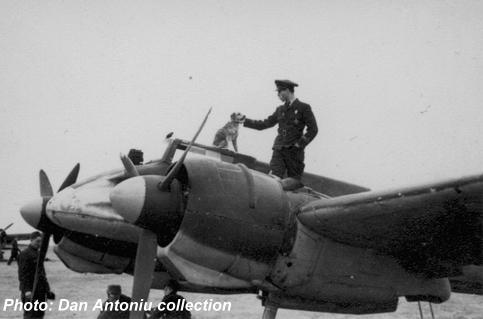
Picture courtesy of Mr. Dan Antoniu
Hs-129B2 on an airfield in Moldavia, summer 1944.
On 12 May, during an attack against a Soviet infantry and tank column, adj. maj. av.
Stefan Pucas saw several Il-2s heading towards Romanian lines.
After dropping his bombs he attacked the head aircraft of the enemy formation. The 20 mm
shells hit the Soviet's ammunition and the Sturmovik exploded in midair.
Throughout the rest of May, the group continued to fly missions in support of the troops
on the front. Thus on 1 June 1944, it was reduced to only 15 serviceable aircraft, but it
still managed to make 66 sorties, dropping 35 tons of bombs.
On 30 June 1944, the group moved to the Matca-Tecuci airfield, from where it continued
to carry out its missions. On 3 July, adj. maj. av. Pucas and adj.
av. Victor Dumbravă shot down an Il-2 each.
On 20 August, the Soviet 2nd and 3rd Ukrainian Fronts started the Jassy-Kishinev
Operation. Because of the situation on the front, the 8th Assault Group was relocated to the
Gheraiesti airfield, near Bacău. The Romanian Henshels started imediately to attack the
Soviet mechanized spearheads, that were advancing behind the Axis lines, but suffered
important losses to the Soviet AA defense. Adj. av. Nicolae Davidescu was shot down on 22
by P-39s, while 3 Hs-129s were taken out by the AAA the following day. One of them was adj.
av. Dumitru Marinescu, who had landed to save a downed comrade, but his aircraft was hit
by Soviet fire and could not take off anymore. He was taken prisoner, but managed to escape
several times.
On 23 August, the group moved to the Ianca airfield, where the next day the Germans
stationed armed sentinels near the aircraft. The Romanian pilots fled to Cioara-Doicesti
airfield, where they found troops from the 3rd Romanian Army and even general Petre
Dumitrescu, the CO. The infantry reoccupied Ianca and recaptured the airplanes. The 17
Hs-129B2s were then taken to Craiova, where the Romanian Air Corps was reorganizing. The
8th Assault Group flew only one mission from there at the beginning of September, when
four Henschels attacked a German convoy on the Danube.
On 6 September, the 41st and 42nd Squadrons moved to Balomir airfield, on the front in
Transylvania,
from were it had to fly against the German and Hungarian forces. But the Soviets occupying
the base arrested the pilots and confiscated the aircraft. At the intervention of gen.
de escadră av. Emanoil Ionescu they were set free and on 8 September the first 5 Hs-129s
made an armed reconnaissance in the Ocna Muresului - Târnava Mică area and bombed Hungarian
troops. Another five aircraft struck an enemy column, destroying 25 trucks. The following
day, they made 21 sorties. Slowly things were becoming "normal" again for the assault
pilots. On 14 September 8 Henschels surprised a German column south of Cluj, knocking out
18 tanks. Another 12 attacked a truck and cart column with good results. Three aircraft
were shot down, one by Soviet AAA because of a questionable error of identification.
On 16 September, the 8th Assault Group intervened in the support of the Păulis
Detachment, which was struggling with its feeble forces to hold back the 1st Hungarian
Armored Division. 8 vehicles were destroyed by the five Hs-129s. During the following
days the Romanian assault aircraft returned many times to Păulis. On 17 September, 8 Hs-129s
dive-bombed the Axis armored attacked, destroying 8 tanks. After releasing the load, they
emptied their guns and machine-guns in the enemy infantry positions.
While taking part in the battle of Păulis, the 8th Assault Group also had to provide
support to the forces of the 4th Army fighting in the Turda area. On 18 September, four
Henschels attacked a 25 truck column west of the town causing a lot of damage. They
dived from 1,200 m and launched the bombs very precisely. They turned after pulling out of
the dive, lined up and passed at low altitude over the burning column, firing the on-board
artillery at the remains and then they flew away, without a loss. Between 8-19
September the group had made 112 sorties. On 20, the 60th Squadron joined the group on
the front.
The Soviet-Romanian offensive started on 22 September. 12 Hs-129s attacked German
infantry positions near Cluj. Adj. av. Trifan Bulhac was hit in the right engine by a
Luftwaffe Bf-109G. Lt. av. Lazăr Munteanu tried to guide him back to the airfield, but
Bulhac was forced to crash land the aircraft. So lt. av. Munteanu landed near him, got him
out and, with the help of a Soviet soldier, transported him to Blaj in his Hs-129. Lt. av.
Munteanu was also shot down by Axis AAA, during the third mission of the day. In total 35
sorties were flown on 22.
The next day they resumed the attacks in the Turda area, with 26 sorties and 10.5 tons
of bombs dropped. During the first mission 9 Henschels destroyed several artillery batteries
and four trucks. In the afternoon 8 aircraft surprised a column of 30 trucks and 30 carts
on the road between Turda and Cluj and bombed it. What was not destroyed in the first pass
was scattered. But they lost slt. av. Ovidiu Ungur, whose damaged Hs-129 exploded when he
tried to make an emergency landing.
On 24 September the group made 25 sorties and dropped 7.5 tons of bombs on infantry
positions and setting several cars on fire. On 25, 8 Hs-129B2s attacked Axis trucks at
Ceanu Mic, destroying four of then and then struck a tank column, of which lt. av. Lazăr
Munteanu knocked 2 out. One aircraft was damaged by Bf-109s and had to make an emergency
landing.
The offensive was renewed on 9 October and the 8th Assault Group was again in the first
wave, attacking German infantry positions and columns and destroying 30 carts and 9 trucks.
However, the last month of war had reduced the numbers of Hs-129s and Ju-87s available
in the ARR inventory. There was no possibility to replace them. so the decision to
reorganize
this material was taken. On 11 October, all the remaining Henschels were reunited in the
41st Squadron. This squadron and the 74th Dive Bomber Squadron (Ju-87Ds) formed the 8th
Assault-Dive Bomber Group, under the command of cpt. av. Ioan Eftimopol.
The new unit started to fly again on 16 October. on this page I will concentrate on the
41st Assault Squadron and its Henschels. Eight aircraft were sent to attack German positions
60 km behind enemy lines. The airplane of adj. av. Jean Marinescu was hit and he was forced
to land near Bistrita-Năsăud. He was severely wounded in the crash and was later forced to
give up flying because of problems with the spine.
On 18 October, 8 Hs-129s wrecked havoc in Axis columns destroying 50 carts and 2 cars.
They also attacked the Săntău railroad station, where they blew up two trains. The next day
they destroyed 20 carts and three trains at Arcas station. An unusual episode ocurred on 20
October. Two Germans, which were trying to get back to their lines, climbed into a Ju-87D
and started to taxi on the runaway, but the pilot was could not control the aircraft to well
and collided with a Hs-129 parked on the airfield. Thus the 41st Assault Squadron lost
another irreplaceable aircraft.
After the German and Hungarian forces were pushed out of Transylvania, the 8th Assault-
Dive Bomber Group was moved to the Turkeve airfield, in present-day Hungary, on 14 November
1944. But because of the muddy airfield and weather conditions, the Hs-129s could not
operate, just like they didn't between 26 October - 4 November. The only mission they
executed was against the airfields near Budapest and Szekesfehervar on 22 November.
Several aircraft were moved to the Madaras airfield, which had a concrete runaway, but
one Henschel was lost in the process by adj. av. Dumbravă. In December the group moved to
Miskolc airfield, in Northern Hungary. On 12, lt. av. Lazăr Munteanu led four
aircraft in an attack on the Vadna railroad station, where he destroyed a command train. The
following day 6 Hs-129B2s attacked Vadna again, destroying four trucks and dropping 1.8 tons
of bombs. On 16 December, four Henschels attacked two trains at Putnok. On 19 December, the
weather cleared and allowed six aircraft from the 41st Squadron to attack a German column
in present-day Slovakia. On 20, the squadron made 16 sorties, destroying several cars at
Rimavska and a train at Rimsobota.
On 23 November, cpt. av. Ion Eftimopol, the group's CO, led an attack against the bridge
at Filakovo, which they destroyed. His aircraft was hit by the German AAA, but he managed
to bring it back safely. The front needed them also on Christmas, when the Hs-129s attacked
a large munitions column and destroyed over 30 trucks in the Filakovo region.
The missions kept on coming in the first days of January 1945. On 2, the Hs-129s strafed
a German column near Lucenec and on 5 they destroyed a 60 wagon train loaded with fuel, as
well as a munitions train. On 13 January, the 8th Assault-Dive Bomber Group was sent
in a special mission to destroy the Elisabeth Bridge in Budapest. The 41st Squadron was
supposed to come in first and take out as many AA guns as it could, in order to make the
job easier for the Stukas of the 74th Squadron. Cpt. av. Eftimopol led his men in this
action, which ended with very good results. Unfortunately, the following day, the
group lost in an accident adj. stg. (r) Vasile Scripcaru, the ARR's WWII cartoonist.
On 5 February the group moved to Lucenec airfield, from where it supported the 4th
Romanian Army in the fights near Zvolen, Kremnika and Banska Bystica. The very same day they
attacked enemy positions near Zvolen. On 6, it took the 20 Hs-129s available 4 missions
to pulverize the German fortified positions near Detva, which were holding back the Soviet
40th Army. The following day another comparable effort against the Halic railroad
marshalling yard, again without loss.
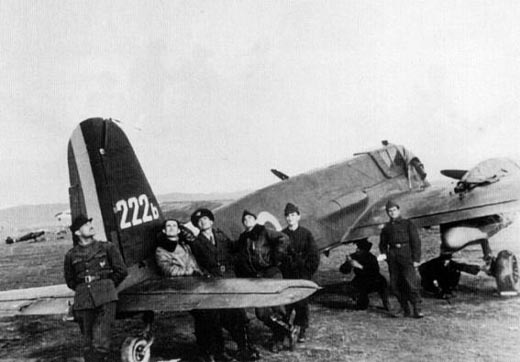
Picture from "Henschel Hs-129 in action" by
Dénes Bernád, Squadron/Signal Publications, 1998
Pilots from the 8th Assault Group on Lucenec airfield, Slovakia, in
February 1945. This aircraft was used by lt. av. Lazăr Munteanu.
A controversial incident occured on 9 February, when two IAR-81Cs from the 2nd Fighter
Group intercepted a Romanian Hs-129 which was attempting to desert and shot it down.
The pilot, adj. av. Dumitru Marinescu and the two passengers were wounded. The irony was
that the two IAR-81 pilots and the one on Hs-129 had been comrades in the former 8th
Fighter Group.
Between 17 and 19 February the Hs-129s dropped 8 tons of bombs on Germans positions in
the Zvolen area, destroyed two trains, one of which was carrying tanks, and strafed several
columns.
On 4 March, the 41st Squadron flew 32 sorties against another German fortified line and
facilitated the creation of a breach 15 km long and 5-8 km deep by the infantry. The
following days, the Hs-129s destroyed 2 artillery batteries and many machine-gun positions
west of Zolna, as well as two fuel depots, trains and columns in the Dobra Niva
area. Between 25 February and 25 March, the 8th Assault-Dive Bomber Group made over 300
sorties, the majority with 41st Squadron's Henschels.
The group was relocated to the Zvolen airfield. The beginning of April was very full
of action. On 4, 5, 7, 8, 9 and 10 April, the Hs-129s attacked German troop concentrations
and columns in the Prievidza and Novaky areas, in support of the 4th Romanian Army. On
11 April, 14 aircraft attacked the Rajec-Sillein highway, destroying over 20 cars. On 15,
the Romanian pilots destroyed 30 cars at Mikovitz, two trains and an engine at Schumitz
railroad station. But during the last mission, adj. maj. (r) av. Vasile Pascu suffered an
internal bleeding when he was pulling out of a dive. He made it back to the airfield with
difficulty and was taken to the hospital in Zvolen.
On 16 April the old age and extensive use of the Hs-129s showed, when lt. av. Munteanu's
aircraft experienced an engine failure and had to land on the Trencin airfield, which was
exactly on the front line. He took refuge with a Soviet infantry unit, but the Henschel was
destroyed by German mortar fire. The following day he was back in action. The pilots of
the 41st Squadron destroyed 30 cars at Kortina and 60 carts at Priscen.
The 8th Assault-Dive Bomber Group was then engaged in the battle for Uhersky Brod. The
fighting peaked on 26 April, when the Hs-129s made 24 sorties. Unfortunately for one of the
missions, the Soviets provided a wrong situation of their troops, which led to a friendly
fire incident and one decimated Soviet infantry regiment.
The group moved to Piestany. It also received a new commander: cpt. av. Ion Vlăsceanu.
The first mission in May was flown by two Hs-129B2s, which destroyed four trucks at
Ostrokovitz. The weather did not allow any flights until 5 May, when the entire squadron
hit the Golesov railroad station and depot with good results. But the AA defence managed
to damage one aircraft, which had to make a forced landing in the Soviet lines. The activity
continued on 7 and 8 May.
Even though the armistice was announced on 9 May, the elements of the Vlasov Army did not
want to surrender to the Red Army. They were entrenched in a forest north-north-west of
Uhersky Brod and had 10 to 15 tanks. The 41st Squadron bombed their positions and then
emptied their guns among the trees. They returned after reloading and turned the forest into
a torch, destroying 10 tanks in the process. Trucks and troops came out and started to flee,
but were quickly hunted down. On 10 May, the Henschels made another mission, the last
one of the war for them, in the same area, where they destroyed several abandoned vehicles.
The troops started to surrender.
Thus ends the story of a unique and special ARR unit. Throughout its service it was the
one that probably saved more infantrymen (Romanian, German and Soviet) then any other. Five
"Mihai Viteazul" Orders 3rd class were awarded to its officers. But the forgotten heroes
are the NCOs, who made up the majority of its pilots. |